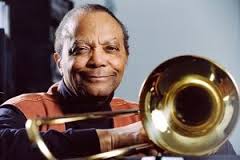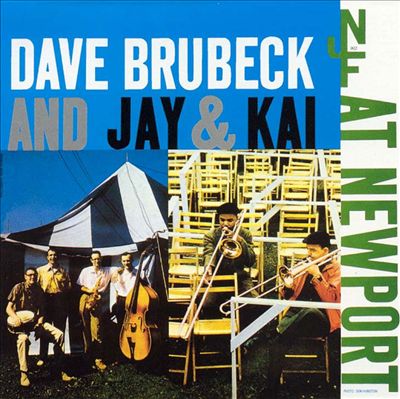NWPT – J.J. Johnson
A medium up swinger—rhythm changes with a twist and an elegant example of J.J.'s composing and arranging. Lead sheets and the original quintet arrangement are both available.
- Recording: J.J. Johnson / Kay Winding - Jay And Kai At Newport
- Recorded on: July 6, 1956
- Label: Columbia (CL 932)
- Concert Key: B-flat
- Vocal Range: , to
- Style: Swing (medium up)
- Trombone - J.J. Johnson, Kai Winding
- Piano - Dick Katz
- Bass - Bill Crow
- Drums - Rudy Collins
0:00
0:00
Buy MP3
Video
- Description
- Historical Notes
- Solos
- Piano Corner
- Bass Corner
- Drum Corner
- Guitar Corner
- Inside & Beyond
- Minus You
This is almost a "rhythm changes" song, but not quite. Instead of moving toward the IV chord in the fifth and sixth measures, it goes directly to the ♯IV (E♮) for a series of descending II-Vs with one tritone substitution - E♭ instead of A. The melody, like many of J.J.'s, is simple and rhythmic with a lot of hits, similar to his improvising style. It is definitely an interesting quintet arrangement, but also works great simply as an AABA head to play and solo on.
About the arrangement: J.J.'s quintet arrangement for two trombones and rhythm section starts with an eight-measure intro, an expansion of the descending II-Vs of the A section. In the first three measures the trombones are in counterpoint, but then come rhythmically together for some harmonized hits. The two-horn voicings in the head are very tight, mostly thirds and seconds.
The last chorus begins with a piano solo, with the trombones playing half notes in harmony softly for the second four measures before playing rhythmic send-off figures for the first four measures of the second A-section and the bridge. The piano fills in the rest, and the last A-section is arranged the same as the first A of the head, with a classic ascending figure at the end that is a J.J. trademark.
About the arrangement: J.J.'s quintet arrangement for two trombones and rhythm section starts with an eight-measure intro, an expansion of the descending II-Vs of the A section. In the first three measures the trombones are in counterpoint, but then come rhythmically together for some harmonized hits. The two-horn voicings in the head are very tight, mostly thirds and seconds.
The last chorus begins with a piano solo, with the trombones playing half notes in harmony softly for the second four measures before playing rhythmic send-off figures for the first four measures of the second A-section and the bridge. The piano fills in the rest, and the last A-section is arranged the same as the first A of the head, with a classic ascending figure at the end that is a J.J. trademark.
This is the only known recording of this song; it was probably written specifically for the Newport Jazz Festival. J.J. Johnson and Kai Winding, with their quintet, established a trombone equivalent to the great tenor saxophone pairings of Gene Ammons and Sonny Stitt, Al Cohn and Zoot Sims, and Johnny Griffin and Eddie "Lockjaw" Davis. With their mellow, elegant sound, J.J. and Kai were most like Al and Zoot, out of these combinations; however, the two trombonists had very different sounds. J.J. was the smooth one, and though Kai could be smooth, his improvising was a bit more overtly exciting and trumpet-like.
For another song by J.J. and Kai's quintet, check out Tromboniums In Motion from the "Jay And Kai" album. This studio session features almost the same personnel as the Newport date except with drummer Kenny Clarke replacing Rudy Collins. Collins is mostly known for his work with Dizzy Gillespie, with whom he played from 1962 to 1965. As you can see from his playing here, he deserves to be better known; with Dizzy he was instrumental in developing the samba and several other Latin grooves for drumset.
J.J. had a habit of naming his compositions in a very practical way. When he got a computer and started using sequencing software to compose, the first song he sent to Second Floor Music was called Save Often. Everyone from the early computer days understands what that means! From George Avakian's liner notes: "J.J.'s contribution is the closing piece, which he hadn't titled when he gave it to his copyist. The latter unwitting provided a name for it, albeit a difficult one to pronounce, when he stamped 'NWPT' on the parts as a means of identifying the composition. J.J. took one look and decided that that was the title from now on."
For another song by J.J. and Kai's quintet, check out Tromboniums In Motion from the "Jay And Kai" album. This studio session features almost the same personnel as the Newport date except with drummer Kenny Clarke replacing Rudy Collins. Collins is mostly known for his work with Dizzy Gillespie, with whom he played from 1962 to 1965. As you can see from his playing here, he deserves to be better known; with Dizzy he was instrumental in developing the samba and several other Latin grooves for drumset.
J.J. had a habit of naming his compositions in a very practical way. When he got a computer and started using sequencing software to compose, the first song he sent to Second Floor Music was called Save Often. Everyone from the early computer days understands what that means! From George Avakian's liner notes: "J.J.'s contribution is the closing piece, which he hadn't titled when he gave it to his copyist. The latter unwitting provided a name for it, albeit a difficult one to pronounce, when he stamped 'NWPT' on the parts as a means of identifying the composition. J.J. took one look and decided that that was the title from now on."
Related Songs
Email Send NWPT to a friend
Send this page to a friend via email. Add your name or email in the first field. In the second, add one or more email addresses, separated by a comma.

J.J. Johnson
January 22, 1924 – February 4, 2001
J.J. Johnson is arguably the most influential bop and post-swing trombonist and also one of the great composers and arrangers in jazz. He was one of the first trombonists to embrace bebop; his playing continues to exert a strong influence on other musicians. He started his recording career in 1942 in Benny Carter's big band. On July 2, 1944, J.J was on the first Jazz At The Philharmonic concert. He recorded with the Count Basie Orchestra beginning in 1945. Read more...
There was a problem.
...

